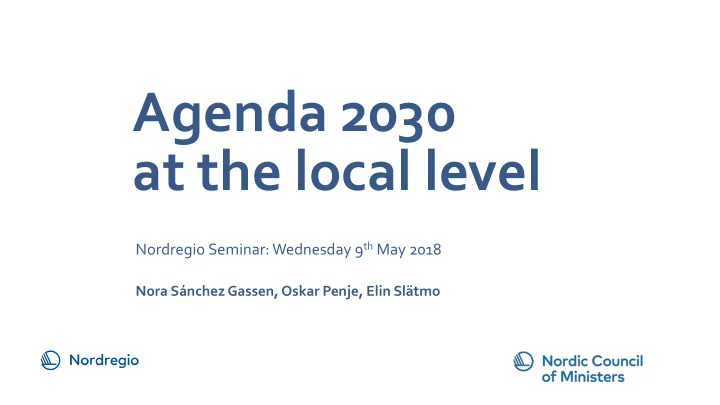

Agenda 2030 at the local level Nordregio Seminar: Wednesday 9 th May 2018 Nora Sánchez Gassen, Oskar Penje, Elin Slätmo 1
Research questions and project goals Research questions: o Which Nordic municipalities are the frontrunners in working with the Agenda 2030 and the Sustainable Development Goals (SDGs)? o How do they work with the SDGs?
Research questions and project goals Project goals: o Organisation of a seminar on 9 May 2018 at Nordregio o Publication of a report to the NCM (July 2018)
Project team Nora Sánchez Gassen Oskar Penje Elin Slätmo
Approach o Identification of interesting municipalities: Request for suggestions from Nordregio’s network o Conditions for interviews: 1) Explicit reference to SDGs in municipal work, 2) beyond planning stage If too many suggestions: Focus on most frequently mentioned cases o Interviewing municipalities: Predefined questionnaire o Writing profiles of municipalities for report:
Who are the frontrunners? Iceland (2) Kópavogur Mosfellsbær Norway (8) Arendal Asker Bergen Eid Hurdal Kristiansund Stavanger Tingvoll Finland (5) Espoo Kemi Pirkkala Tampere (Vaasa) Åland (1) Mariehamn
Who are the frontrunners? Sweden (8) Åtvidaberg Gotland Helsingborg Malmö Örebro Umeå Uppsala Växjö Denmark (5) Aarhus Copenhagen Gladsaxe Odense Sønderborg Faroe Islands (1) Tórshavn Greenland(1) Sermersooq
How do they work with the SDGs? Goals and priorities: 1. Which goals do municipalities pursue? To become one of the most sustainable cities in the world (Copenhagen) To become a green and sustainable city (Kemi) To reduce our environmental impact and create a good living environment (Mariehamn) To promote the quality of life at all ages (Stavanger) To become carbon-neutral (Aarhus) To build a sustainable suburb (Sermersooq) … and many more goals !
How do they work with the SDGs? Goals and priorities: 2. Do the municipalities prioritize some SDGs more than others? Some municipalities work with all SDGs: e.g. Växjö, Sønderborg, Copenhagen, Malmö, Hurdal, Åtvidaberg Others prioritise some SDGs: e.g. Tampere: SDGs 8 and 9 Umeå: SDGs 11 (and 5) Mariehamn: eight SDGs
How do they work with the SDGs? Approaches and tools: 3. How do municipalities define their priorities? City strategy (Kemi, Gladsaxe) Environmental programmes (Mosfellsbær, Tórshavn, Odense) Sustainability programme (Åtvidaberg, Växjö) Climate plan (Aarhus, Arendal) Health/quality of life plans (Umeå, Helsingborg) Indicators based on Social Progress Index (Kópavogur) Commitment 2050 webpage (Finnish municipalities)
How do they work with the SDGs? Approaches and tools: 4. Which approaches do they use to implement their goals? Many different approaches Frequently used: - Evaluation of existing policies/programmes/steering documents - Defining future goals and priorities
How do they work with the SDGs? Involving the public: 5. How do the municipalities reach out to their populations? Citizen consultations, seminars: Mosfellsbær, Växjö, Gotland Board games, puzzles: Aarhus, Copenhagen, Odense App and website: Sønderborg Sustainability award: Odense Positive scenarios ‘Images of the future’ : Kristiansund Business incubators for women and social entrepreneurship: Helsingborg
How do they work with the SDGs? Involving the public: 6. How do the municipalities involve young people? Science center and book adapted to kids: Gotland Workshops, learning weeks: Sønderborg Child hearing, youth dialogues: Helsingborg, Uppsala Student/youth councils: Umeå, Aarhus, Mosfellsbær Innovation camp for young entrepreneurs: Asker
Tampere (FI) • Population: ca. 225.000 persons • Most populous inland city in the Nordics • Tradition of heavy industry Source: By Tiia Monto - Own work, CC BY-SA 3.0, https://commons.wikimedia.org/w/index.php?curid=27332380
Tampere (FI) Unique for: All sectors of government are challenged to improve sustainability, but given space to develop own ideas o Municipal working group has been meeting since March 2017 o Activities: Evaluation of where the municipality is standing o Commitment on Finland’s “Commitment 2050” -webpage: “ Sustainable economic and innovation policy and responsible procurement “ o Working group tries to activate all sectors of government to get involved
Gladsaxe (DK) • Population: ca. 69.500 persons • Close to Copenhagen Source: By Claus B. Storgaard - Own work, CC BY-SA 2.5, https://commons.wikimedia.org/w/index.php?curid=6855626
Gladsaxe (DK) Unique for: Clear strategic municipal planning with links to the SDGs o SDGs are used as a tool to link the different sectors of government o New city strategy: uses the SDGs to “raise the bar” o Strategy defines six goals for the city (e.g. Green and vibrant city), o Each goal is connected to activities and linked to the SDGs o All administrative activities should be geared to reach these goals o Use of SDGs clearly grounded in municipal priorities and interests
New Asker (NO) • Population: ca. 93.000 persons • Close to Oslo Source: By Trarir - Own work, Public Domain, https://commons.wikimedia.org/w/index.php?curid=10757235
New Asker (NO ) Unique for: Agenda 2030 built into the municipal plan o A new municipality when Asker is merged with Røyken and Hurum 2020. o The SDGs will serve as the basic framework for the municipal plan o A separate committee work with establishing guidelines and methodologies to be built into the plan.
Umeå (SE) • Population: ca. 125.000 persons • Largest city in Norrland • Björkarnas stad Source: By Tage Olsin, CC-BY-SA-2.0, https://commons.wikimedia.org/wiki/File:Ume_alv_in_Umea.jpg
Umeå (SE) Unique for: Activities to reach out to the population o Umeå puts a particular emphasis on SDG 11 in their work. o Many activities, e.g. related to air quality and transport o SEE sustainability week (social, economic and ecological): Presentations, exhibitions, competitions, activities, events o Annual project work and consultations with upper secondary school about sustainability and the future
Conclusion o Municipalities are just starting to work with the Agenda 2030. o But very inspiring examples, many good ideas o Municipalities are very active already in promoting economic, social and ecological sustainability o But: Often not (yet) linked to the SDGs: competing frameworks, lack of time/staff, lack of knowledge o Our goal: Report as a source of inspiration for other municipalities
Thanks.
Recommend
More recommend